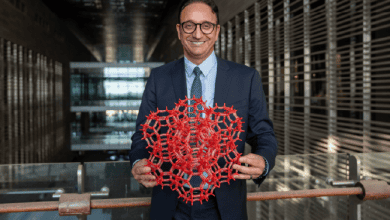Monitoring Earth from Space: Mohamed Sultan’s Legacy in Remote Sensing
How Satellite Technology Is Unveiling Hidden Patterns on Earth

“With the capabilities of today’s satellites, we can monitor natural disasters, track climate change, manage resources, and understand and protect our world” Mohamed Sultan
إن حماس محمد سلطان للاستشعار من بُعد، وهي تقنية “العين في السماء” التي تستخدم الأقمار الاصطناعية لالتقاط صور وقياسات مفصلة لسطح الأرض، أمر واضح. إذ تكشف هذه التقنية عن أنماط وتغيرات خفية لا يمكن رؤيتها بالعين المجردة. ويقول الأستاذ الدكتور في قسم العلوم الجيولوجية والبيئية بجامعة ميشيغان الغربية: “نحن نعيش في وقت مناسب تماماً للعلماء الذين يعملون مع أرصاد الأقمار الاصطناعية. وبفضل قدرات الأقمار الاصطناعية اليوم يمكننا مراقبة الكوارث الطبيعية، وتتبُّع تغير المناخ، وإدارة الموارد، وفهم وحماية عالمنا”.
Throughout his career, Sultan has championed the application of science for societal benefit. At 72, he shows no signs of slowing down. On the contrary, he remains deeply engaged in research and currently leads international projects on global warming. His group uses global climatic models for the 21st century and hydrologic models to predict the intensity and frequency of flooding and drought events in the Nile’s downstream countries of Egypt and Sudan and across the Arabian Peninsula.
Sultan was born in October 1952 in Cairo, Egypt, a city with ancient and diverse geology. His childhood was good, shielded, and privileged. His father was a pulmonary physician, the director of the largest pulmonary hospital in Egypt at the time, and his mother, a graduate of the American University in Cairo, was a reporter in the Egyptian Gazette, the oldest daily newsletter in the Middle East. He received his primary and secondary education at the English School in Heliopolis, Cairo, a private British school. Initially, he wanted to become a civil engineer, but geology, specifically geochemistry, eventually won him over. “I always wanted to understand the Earth's secrets,” Sultan said. He pursued bachelor’s and master’s degrees in geology at Ain Shams University, fully committing to geological sciences in the process. In 1978, he moved to the US to pursue a PhD degree at Washington University in St. Louis, funded by a scholarship from the Department of Earth and Planetary Sciences.
يقول سلطان: “لقد اخترت هذه الكلية لأنها كانت دائماً واحدة من أفضل برامج الجيولوجيا، وهي حالياً واحدة من أفضل 20 كلية جيولوجية في الولايات المتحدة”. بعد حصوله على درجة الدكتوراه تلقى سلطان عرض عمل من منشأة تابعة للوكالة ناسا في جامعة واشنطن، حيث بدأ العمل ببيانات الاستشعار من بُعد لدراسة التمعدن – العملية التي يحدث بها ترسُّب المعادن في مسام الصخور أو التربة أو الرواسب، مما يؤدي إلى تكوين رواسب معدنية صلبة – في جبال سانت فرانسوا المذهلة في ميسوري. كان انتقال الأكاديمي المصري إلى الاستشعار من بُعد مصادفة وخبرة تحويلية.
“They were looking for someone with my background,” he noted, describing his entry into NASA’s satellite imaging projects. He jumped at the opportunity immediately. He thought of developing methodologies by which observations from space could identify the mineralogy and environmental chemistry of materials on the surface of the Earth. There is no better place to achieve his goals than the Sahara of North Africa and Arabia, where the rocks are not covered by vegetation or snow and the skies are clear year-round. Sultan quickly moved his research from the St. Francois Mountains to Northern Africa and the Arabian Peninsula. This intersection of geology and technology in these arid areas opened new vistas for Sultan, leading to his long-standing contributions to the field.
Today, at Western Michigan University and after positions at Argonne National Lab and SUNY Buffalo, among others, Sultan leads a dynamic research group that integrates satellite imagery with field data to address diverse environmental issues. He believes that the integration of his Arabic cultural heritage with the scientific rigor of the US is a killer combination: “The result is scientists that emit warmth and strong work ethic at the same time,” he said. Importantly, Sultan’s contributions to pressing environmental issues in the Arab world remain irreplaceable, even from across the pond.
ومن بين المشاريع البارزة التي ينفذها سلطان تحليل تأثير سد النهضة الإثيوبي الكبير في مصر والسودان. وسد النهضة هو مشروع سد كبير على نهر النيل الأزرق في إثيوبيا، يهدف إلى توليد الطاقة الكهرومائية وتنظيم تدفق المياه. ويستخدم فريقه بيانات الأقمار الاصطناعية لدراسة توزيع المياه وتأثيراتها في دول المصب. وهذا أمر بالغ الأهمية ليس فقط للتنبؤ بالفيضانات المحتملة والحد منها – وخاصة في مواجهة الأحداث الجوية غير العادية التي من المؤكد أن يُسبِّبها تغيرُ المناخ ــ ولكن أيضاً لإثراء المفاوضات واستراتيجيات إدارة المياه العادلة بين الدول.
في الأساس يساعد عمل سلطان في الحفاظ على الاستقرار الإقليمي: تضمن بيانات الاستشعار من بُعد أن تكون القرارات مبنية على معلومات دقيقة وفي الوقت الفعلي، مما يساعد جميع الدول المتضررة على التخطيط وإدارة مواردها المائية قبل فوات الأوان. في شبه الجزيرة العربية يستخدم فريقه بياناتِ الأقمار الاصطناعية لرصد مستويات المياه الجوفية والتنبؤ بتوافر المياه. في قطر والمملكة العربية السعودية، يتتبعون تضاريس الأرض لإدارة البنية التحتية، بينما في عُمان يدرسون تأثير الأعاصير في إعادة شحن المياه الجوفية. أما في الدرع العربي النوبي المهيب، يستخدمون التحليل الطيفي، الذي يفحص أنماط الضوء للعثور على الموارد المعدنية المُخفاة. كل هذا يساعد مهمة الوكالة ناسا ودراساتها في مصادر الغبار المعدني على سطح الأرض (EMIT) ومبادرة المعادن الحرجة التابعة للمسح الجيولوجي الأمريكي. يفخر سلطان كثيراً بالجمع بين خلفيته في علم المعادن وشغفه الذي اكتشفه لاحقاً بالاستشعار من بعد بطرق رائعة ومؤثرة.ويقول: “حظيتُ بأفضل ما في العالمين، فأنا أعمل في مكان يتمتع بقدرات هائلة وبالخبرة التي اكتسبتُها هنا مع الحفاظ على علاقات وثيقة مع المؤسسات المصرية والعربية”.
Many academics develop a Napoleon syndrome, becoming aloof and preoccupied with abstract worlds, viewing students as acolytes rather than as talents to be developed but not Sultan, hopefully. “I treat my students as if they were my children. I want them to be respected professors and people I'm proud of,” he said. His “children” agree. “A Journey of Growth and Belonging” are the words that his PhD student Aylin Yildirim uses to describe her experience with him. Yildirim is a Turkish student in her twenties who recently joined his research group to correlate the geology, structures, and mineralization along the Red Sea length using EMIT data. “As an international student, I faced many challenges in a new country. However, feeling safe and comfortable in Dr. Sultan’s lab has given me the strength to move forward.” She parallels working in Sultan’s group as working hard while feeling at home. “I have no concerns or hesitations about my future as a member of this family,” Yildirim concluded.
Recently, Sultan received the 2023 Kuwait Prize for Applied Sciences. “I'm so honored and very happy with it,” he said. “It feels great to be recognized by my people, the Egyptians, the Kuwaitis, the Arabs,” he continued. This award culminates Sultan’s impact on applied sciences and hydrology, particularly in the Arab world. It celebrates his efforts to leverage science for societal benefit, a mission that has defined his career. This mission shows no signs of waning. In addition, age is just a number, everyone deep inside knows. “I enjoy what I'm doing,” Sultan said. “I come to work, I have fun, and the potential to improve lives.”




